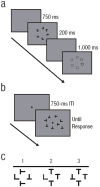A common discrete resource for visual working memory and visual search
- PMID: 23572280
- PMCID: PMC4450974
- DOI: 10.1177/0956797612464380
A common discrete resource for visual working memory and visual search
Retraction in
-
Retraction of "A Common Discrete Resource for Visual Working Memory and Visual Search".Psychol Sci. 2015 Sep;26(9):1527. doi: 10.1177/0956797615602706. Psychol Sci. 2015. PMID: 26354959 Free PMC article. No abstract available.
Abstract
Visual search, a dominant paradigm within attention research, requires observers to rapidly identify targets hidden among distractors. Major models of search presume that working memory (WM) provides the on-line work space for evaluating potential targets. According to this hypothesis, individuals with higher WM capacity should search more efficiently, because they should be able to apprehend a larger number of search elements at a time. Nevertheless, no compelling evidence of such a correlation has emerged, and this null result challenges a growing consensus that there is strong overlap between the neural processes that limit internal storage and those that limit external selection. Here, we provide multiple demonstrations of robust correlations between WM capacity and search efficiency, and we document a key boundary condition for observing this link. Finally, examination of a neural measure of visual selection capacity (the N2pc) demonstrates that visual search and WM storage are constrained by a common discrete resource.
Keywords: ERP; N2pc; evoked potentials; visual attention; visual memory; visual search; working memory.
Conflict of interest statement
The authors declared that they had no conflicts of interest with respect to their authorship or the publication of this article.
Figures



Comment in
-
Findings of research misconduct.NIH Guide Grants Contracts (Bethesda). 2015 Aug 14:NOT-OD-15-141. NIH Guide Grants Contracts (Bethesda). 2015. PMID: 26306340 Free PMC article. No abstract available.
-
Findings of Research Misconduct.Fed Regist. 2015 Jul 31;80(147):45661-45662. Fed Regist. 2015. PMID: 27737259 Free PMC article. No abstract available.
References
-
- Awh E, Jonides J. Overlapping mechanisms of attention and spatial working memory. Trends in Cognitive Sciences. 2001;5:119–126. - PubMed
-
- Awh E, Vogel E, Oh S. Interactions between attention and working memory. Neuroscience. 2006;139:201–208. - PubMed
-
- Baddeley AD. Working memory. Oxford, England: Clarendon Press; 1986.
Publication types
MeSH terms
Grants and funding
LinkOut - more resources
Full Text Sources
Other Literature Sources

